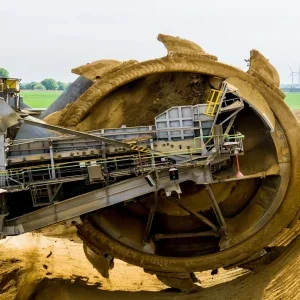Drilling targeted the high-grade Cobalt Ridge prospect, with 18 holes of reverse circulation (RC) drilling for 2086 metres completed. The program’s maximum hole-depth was 174 metres, testing mineralisation to a vertical depth of approximately 130 metres.
The program was successful in intersecting extensive sulphide mineralisation. Initial assessment of RC drill chips by hand-held XRF instruments has confirmed both cobalt and copper are associated with the sulphide mineralisation. All samples have been sent for laboratory analysis; results are expected to be returned before the end of this month.
The Company’s maiden drill program at Mt Gilmore was designed to confirm the continuity, position and extent of the cobalt-copper-gold mineralisation within the Cobalt Ridge prospect area, identified from previous drilling. Corazon’s drilling has supported historical mining and drilling results and has confirmed the presence of multiple zones of sulphide mineralisation over a strike length of 300 metres. The mineralisation remains open along strike and at depth.
Geological assessment of the mineralisation has been encouraging, with multiple phases of brecciation and sulphide mineralisation interpreted. To enhance the understanding of the Cobalt Ridge system, core drilling will commence immediately. This drilling is designed to provide additional information for interpretation and modelling of the mineralisation, as well as provide sample material for petrological and metallurgical test work.
Previous work has identified the high-grade nature of the cobalt-copper-gold mineralisation at Cobalt Ridge (ASX announcement 16 June, 2016). In addition to the Cobalt Ridge prospect, the Project includes multiple promising, recently defined cobalt targets over a strike of approximately 11 kilometres. Fieldwork to test new areas for cobalt-copper-gold mineralisation within the wider Mt Gilmore project area is ongoing.
The Iron Mountain prospect has returned positive cobalt results from past rock-chip sampling. RC drilling is planned to commence at Iron Mountain following the core drilling at Cobalt Ridge.
Core drilling at Cobalt Ridge is expected to be completed over the next three weeks. As with previous drilling, it is anticipated that this drilling will intersect visible signs of mineralisation. The tenor of the cobalt-copper-gold mineralisation will be determined by laboratory analysis, which is expected to take an additional three to four weeks.
Mt Gilmore Project Overview
The Mt Gilmore Project (“Project”) is located only 35 kilometres from the major centre of Grafton in north-eastern New South Wales. Corazon has an exclusive right to earn up to an 80% interest in the Project through payment of cash and shares, plus the expenditure of $2.2 million in-ground (ASX announcements 16 June 2016 and 4 July 2016).
The Project is located in the New England Orogen, a significant mineral province in Eastern Australia with a gold endowment of more the 35M ounces and the potential to host large copper-gold systems.
This region hosts deposits such as the Mount Morgan Cu-Au Mine (+50Mt @ 5.9 g/t Au and 0.7% Cu) and Mt Rawdon Gold Mine (50Mt @ 0.71 g/t Au).
Within the Project, a prospective 18 kilometre trend (the Mt Gilmore Trend) has been identified, including:
More than 25 historic copper, gold, cobalt and iron workings, including significant shafts, adits and drives with high-grade copper and gold mineralisation (rock chips up to grades of 26.8%Cu and 9.2 g/t Au)
Five large scale Cu-Au targets defined to date
Although mapping indicates extensive hydrothermal alteration and copper-gold mineralisation at surface, very little modern exploration has been undertaken. Aside from small-scale historic copper-gold and iron mines, previous exploration has predominantly been restricted to general prospecting/ mapping, rock-chip/ grab sampling, with drilling completed at only one of the targets (the Pulganbar – Cobalt Ridge area).
The Cobalt Ridge Prospect
The high-grade nature of this cobalt mineralisation is published in historical records from shallow mining (maximum shaft depth 36.5 metres), reporting a maximum of 14.7% cobalt (Co), 14.9% copper (Cu) and up to 1.7 oz/ ton gold (Au). The richer mineralisation seemingly occurs in small lenses or pods within a broader zone of lower-grade mineralisation.
Modern exploration within the Project commenced in the 1980’s; PanContinental completed ground IP and magnetic geophysical surveys, gridded soil geochemistry for Cu, Au and Co, 25 trenches (1,518.5 metres) and 17 RC drill holes (for 1,020.82 metres).
Between 2006 and 2008, Central West Gold N.L. drilled 25 holes for 2,880 metres, including 21 holes for 2,604 metres at Cobalt Ridge. This work defined multiple parallel sub-vertical Co-Cu-Au sulphide lodes over a strike of 300 metres and width of between 50 metres and 120 metres. Maximum individual one (1) metre drill results include 3.38% Co, 3.18% Co and 4.92 g/t Au.
The Cobalt Ridge Prospect represents an advanced cobalt play with shallowly drilled Co-Cu-Au lodes that remain open along strike and at depth.
Numerous undrilled regional cobalt prospects exist, including several defined by soil geochemistry and geophysics close to Cobalt Ridge. This style of mineralisation (Co-Cu-Au sulphides) is typically responsive to geophysics, with the Cobalt Ridge mineralisation being traced for at least an additional 100m to 200m under cover outside of existing drilling.






